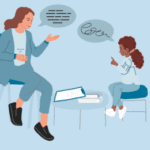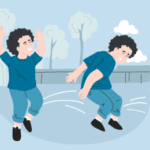
Neurodevelopmental Disorders & Learning Differences
- Dyslexia in Children: Symptoms, Causes & Best Therapies
- Dysgraphia in Children: Symptoms, Diagnosis & Treatment
- What Is Dyscalculia? Symptoms, Causes & Treatment
- Specific Learning Disorder with Impairment in Reading | Symptoms, Treatment & Therapists Near You
- Nonverbal Learning Disorder (NVLD): Symptoms, Causes & Therapies
- What Is Giftedness in Children? Signs, Support & Therapists
- Language Processing Disorder in Children: Signs, Therapy & Support
- Language Disorders in Children: Signs, Types & Therapy
- Delayed Speech in Children: Causes, Signs, and Therapy Options
- Executive Function Disorder in Children: Signs, Support & Therapy
- Apraxia of Speech in Children: Signs, Diagnosis & Therapy
- Understanding Intellectual Disability in Children: Signs, Support & Therapies
- What Is Twice-Exceptional (2e)? Signs, Challenges & Support for Gifted Children with Disabilities
- Global Developmental Delay (GDD)
Nonverbal Learning Disorder (NVLD): Symptoms, Causes & Therapies

Authored by: The DrSensory Editorial Team
Reviewed by: 🛡️ DrSensory Clinical Review Board
Last updated: June 2025
Nonverbal Learning Disorder (NVLD): A Comprehensive Guide for Parents & Professionals
Nonverbal Learning Disorder (NVLD) is a complex neurological condition that affects a child’s ability to process nonverbal cues, such as body language, spatial awareness, and abstract thinking. Though often misunderstood or misdiagnosed, NVLD can impact academic success, motor coordination, social skills, and emotional regulation.
What Is Nonverbal Learning Disorder?
NVLD is characterized by a significant gap between verbal and nonverbal skills.
Children with NVLD often have:
- Strong verbal abilities and early vocabulary development
- Poor visual-spatial and motor skills
- Difficulty interpreting social cues or body language
- Trouble with executive functions and abstract reasoning
Despite the name, NVLD is not about being nonverbal—it refers to challenges in nonverbal cognitive functions such as spatial processing, coordination, and social perception.
Signs and Symptoms of NVLD
Children with NVLD may exhibit a combination of the following symptoms:
Cognitive & Academic:
- Difficulty with puzzles, maps, graphs, or geometry
- Struggles with visual-spatial reasoning
- Strong verbal memory but poor abstract thinking
- Trouble following multi-step instructions
Social & Emotional:
- Trouble reading facial expressions and body language
- Literal interpretation of language (misses sarcasm or jokes)
- Difficulty making or keeping friends
- High levels of anxiety, especially in unstructured environments
Motor & Sensory:
- Clumsiness or awkward gait
- Poor fine motor skills (writing, cutting, buttoning)
- Difficulty with sports or playground activities
- Sensory sensitivities (light, sound, touch)
What Causes NVLD?
While NVLD is not currently included in the DSM-5 as a standalone diagnosis, research suggests it is neurologically based, often involving:
- Right hemisphere brain dysfunction
- Disruptions in white matter pathways
- Genetic or developmental factors
- Coexisting conditions like ADHD, autism spectrum disorder, or anxiety disorders
How Is NVLD Diagnosed?
Diagnosis involves comprehensive neuropsychological testing, often including:
- Verbal vs. nonverbal IQ assessments
- Visual-spatial and fine motor evaluations
- Academic testing
- Speech-language and occupational therapy evaluations
- Parent and teacher input
Professionals involved may include psychologists, SLPs, OTs, and pediatricians.
Effective Therapies for NVLD
NVLD treatment focuses on building compensatory skills while addressing specific deficits in motor coordination, executive functioning, and social-emotional development.
✅ Occupational Therapy (OT)
- Visual-motor integration
- Fine motor coordination (writing, tying shoes, scissor use)
- Sensory regulation strategies
- Executive function coaching (planning, organizing, time management)
✅ Speech-Language Therapy (SLP)
- Social communication training (pragmatics)
- Understanding figurative language and tone of voice
- Narrative and inferencing skills
- Support for written expression and language organization
✅ Physical Therapy (PT)
- Gross motor coordination (balance, running, posture)
- Core strengthening for better endurance and attention
- Spatial awareness training
- Motor planning and body awareness
How Parents Can Support a Child with NVLD
- Use visual schedules and checklists for routines
- Practice role-playing social scenarios
- Give step-by-step verbal instructions
- Break large tasks into smaller, manageable chunks
- Encourage structured play and movement activities
- Work closely with therapists and school staff to ensure support
📍 Find NVLD Therapists Near You
DrSensory offers a nationwide therapist directory of specialists who understand the nuances of NVLD. Our platform helps families find the right care from:
✅ Verified Occupational Therapists, Speech-Language Pathologists, and Physical Therapists
✅ Search by location, specialty, or insurance
✅ In-person and telehealth options
✅ Profiles with credentials and patient reviews
📣 Are You a Therapist Who Supports Children with NVLD?
Join the DrSensory provider network to connect with families looking for NVLD specialists:
- Showcase your expertise in neurodevelopmental and learning disorders
- Reach more clients through targeted search traffic
- Collaborate with multidisciplinary professionals
❓ Frequently Asked Questions (FAQs)
Is NVLD the same as autism?
No. While there is overlap (especially in social challenges), NVLD typically includes strong verbal skills and does not involve restricted interests or repetitive behaviors common in autism.
Can NVLD be treated?
Yes. While NVLD isn’t “cured,” targeted therapies and accommodations help children build the skills they need to thrive academically and socially.
What age is NVLD diagnosed?
Signs may appear in early elementary years, with formal diagnosis typically occurring around ages 6–10.
Is NVLD in the DSM-5?
Not currently. However, many professionals still recognize it as a valid clinical profile requiring intervention.
This page provides general educational content and is not a substitute for professional medical advice. Always consult a licensed provider for diagnosis and treatment.
View privacy policy, copyright and trust info
More on Neurodevelopmental Disorders & Learning Differences

- Dyslexia in Children: Symptoms, Causes & Best Therapies
- Dysgraphia in Children: Symptoms, Diagnosis & Treatment
- What Is Dyscalculia? Symptoms, Causes & Treatment
- Specific Learning Disorder with Impairment in Reading | Symptoms, Treatment & Therapists Near You
- Nonverbal Learning Disorder (NVLD): Symptoms, Causes & Therapies
- What Is Giftedness in Children? Signs, Support & Therapists
- Language Processing Disorder in Children: Signs, Therapy & Support
- Language Disorders in Children: Signs, Types & Therapy
- Delayed Speech in Children: Causes, Signs, and Therapy Options
- Executive Function Disorder in Children: Signs, Support & Therapy
- Apraxia of Speech in Children: Signs, Diagnosis & Therapy
- Understanding Intellectual Disability in Children: Signs, Support & Therapies
- What Is Twice-Exceptional (2e)? Signs, Challenges & Support for Gifted Children with Disabilities
- Global Developmental Delay (GDD)
Find a Therapist near you
Are you looking for a physical, occupational, or speech therapist in your area?
Look no further than the DrSensory Therapist Database and Clinic Directory!
Find a Therapist
Find the physical therapist, occupational therapist, or speech language pathologist you’re looking for!
Ask Us Anything
Whether you are looking for advice, have a general question about sensory processing, or looking for resources.
Submit Your Story
Share your story about your child. Let’s celebrate milestones and learn more about challenges.













































































